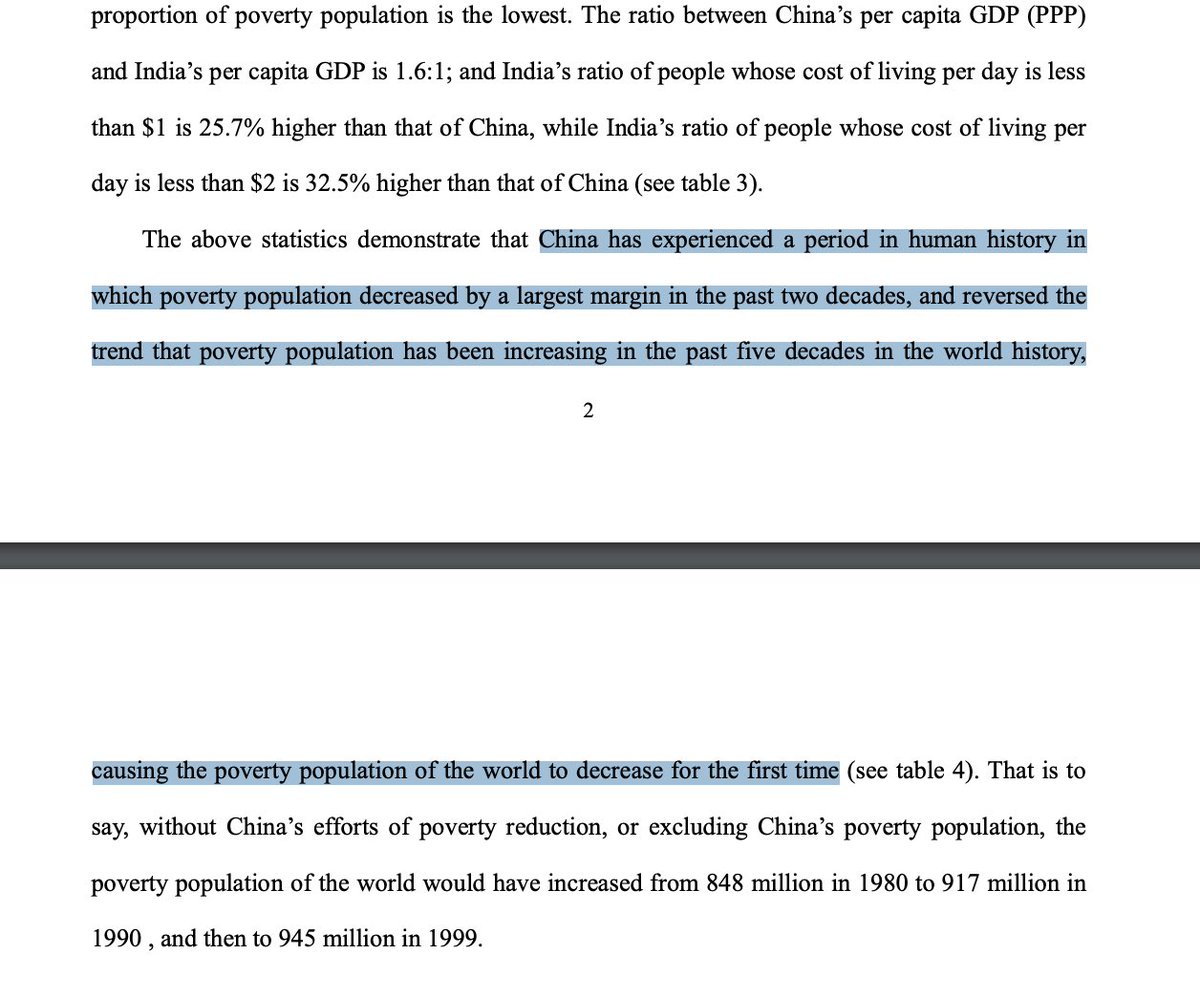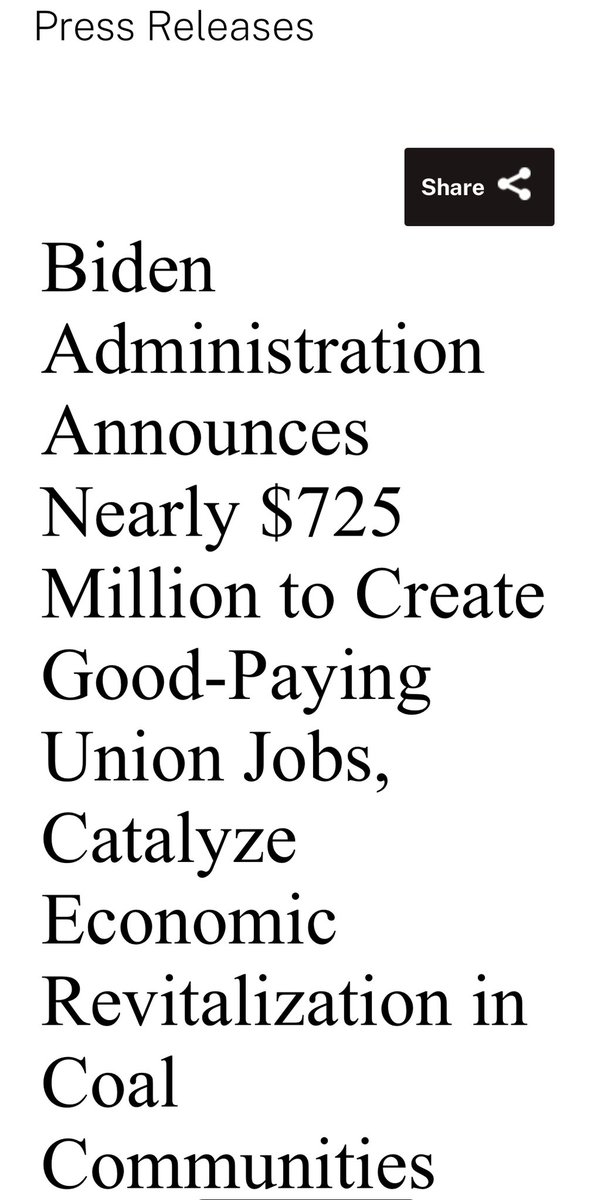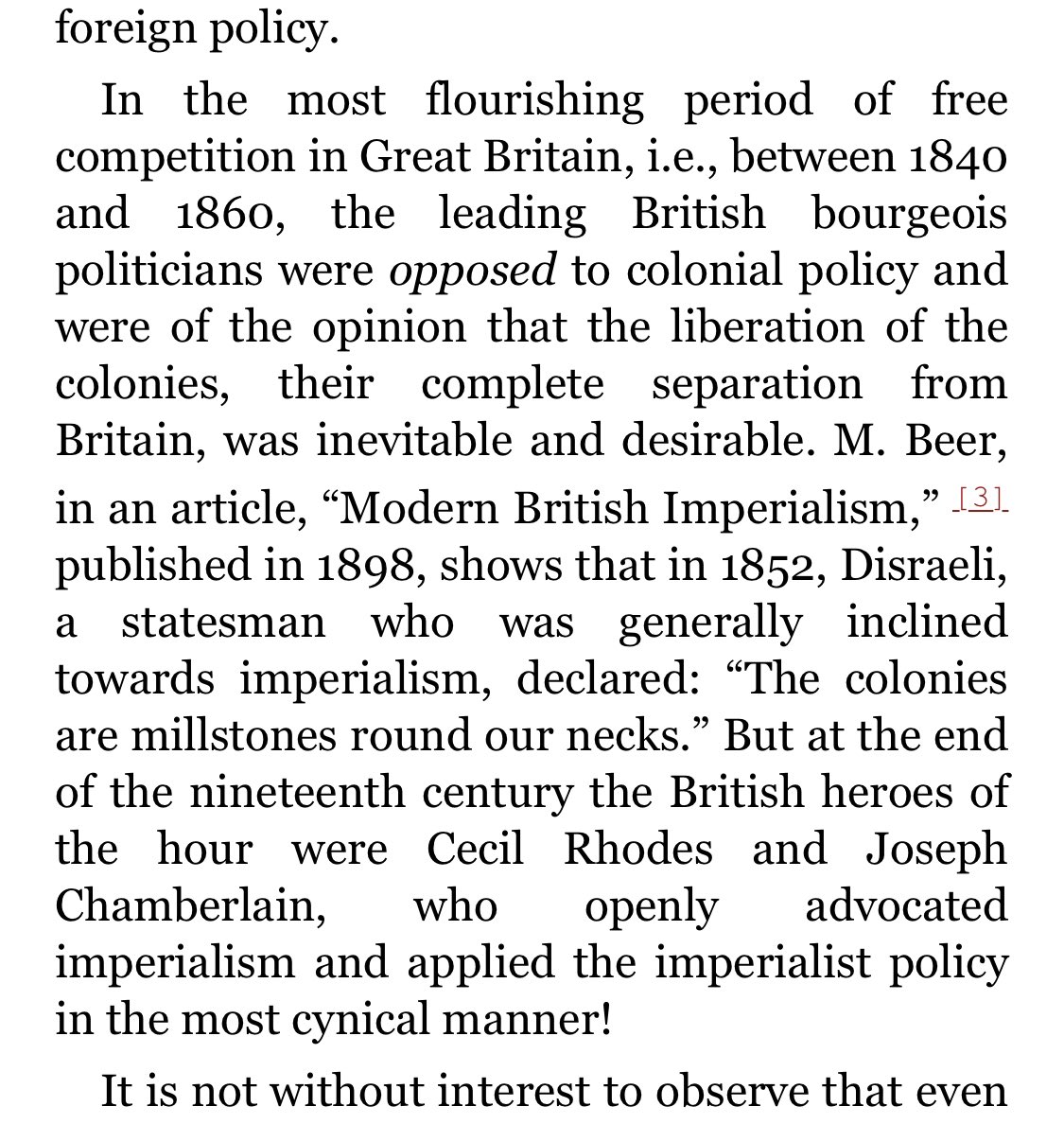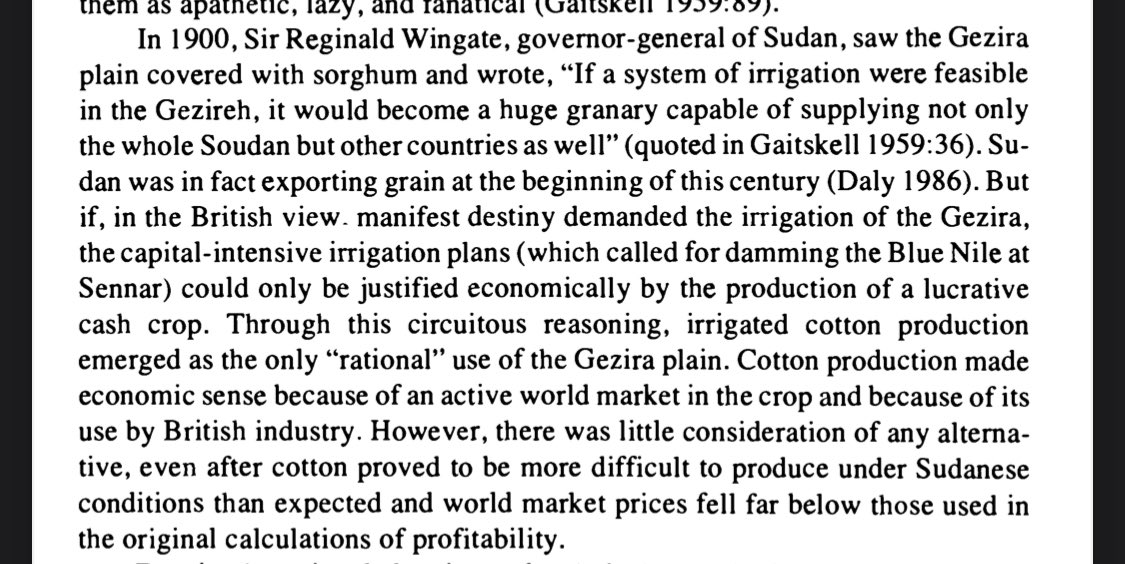
In the west, the poor are getting poorer.
In China, the poor are getting richer.
Thread 🧵
In China, the poor are getting richer.
Thread 🧵
The real (inflation-adjusted) incomes of the poorest half of the Chinese population increased by more than four hundred percent from 1978 to 2015, while real incomes of the poorest half of the US population actually declined during the same time period.
nber.org/system/files/w…
nber.org/system/files/w…

Just from 1978 to 2000, the number of people in China living on under $1/day fell by 300 million, reversing a global trend of rising poverty that had lasted half a century (i.e. if China were excluded, the world's total poverty population would have risen)
semanticscholar.org/paper/China%E2…
semanticscholar.org/paper/China%E2…

In the 21st century, Chinese wages increased even faster. In 2007, The Economist reported that in spite of the mass migration of workers to China’s eastern urban centers, pay for factory workers was rising at double digit rates in the Pearl River delta near Hong Kong. 

The general wage increase seems to have accelerated during the next decade. From 2010 to 2019 (the most recent period for which uninterrupted data is available), the income of the poorest 20% in China increased even as a share of TOTAL income.
data.worldbank.org/indicator/SI.D…
data.worldbank.org/indicator/SI.D…

In major western economies—the US, the UK, and Germany—the poorest 20% had either no change or a decline in income share for same period. France stands out with an extremely slight 0.3% increase.
data.worldbank.org/indicator/SI.D…
data.worldbank.org/indicator/SI.D…

By the end of 2020, extreme poverty, defined as living on under a threshold of around $2 per day, had been eliminated in China. According to the World Bank, the Chinese government had spent $700 billion on poverty alleviation since 2014.
nytimes.com/2020/12/31/wor…
nytimes.com/2020/12/31/wor…
China's ethnic minorities, who for many generations have been the most poor, recently saw the biggest increases in income.
In Xinjiang, per capital rural household income rose by 870% from 2000 to 2020.
stats.gov.cn/tjsj/ndsj/2005…
stats.gov.cn/tjsj/ndsj/2021…

In Xinjiang, per capital rural household income rose by 870% from 2000 to 2020.
stats.gov.cn/tjsj/ndsj/2005…
stats.gov.cn/tjsj/ndsj/2021…


This correlates to minority populations, but even rural northern and eastern Xinjiang have fewer minorities; therefore an average of three prefectures in the south—Aksu, Kashgar, and Hotan—that are overwhelmingly minority-majority in rural areas is more accurate.
In 2000, their average per capita rural household income was 1,161 yuan. By 2020, it had risen to 11,532 yuan, or 993% more.
Adjusted for cumulative inflation of the yuan, this was a nine hundred percent gain in purchasing power.
tjcn.org/tjgb/31xj/3416…
tjcn.org/tjgb/31xj/3687…



Adjusted for cumulative inflation of the yuan, this was a nine hundred percent gain in purchasing power.
tjcn.org/tjgb/31xj/3416…
tjcn.org/tjgb/31xj/3687…




This increase was exceeded in magnitude in only one other place in China—the Tibet Autonomous Region, whose rural households saw an increase in purchasing power of over one thousand percent.
https://twitter.com/KyleTrainEmoji/status/1589433074039021571
Overall, in terms of rural per capita income, Xinjiang improved against the national average, from 72% in 2000 to 82% in 2020. The income gap between east and west in China is closing.
Rural poverty in the United States was not significantly alleviated in that time.
It is also highly correlated to minorities, but their situation currently does not seem to be improving.
It is also highly correlated to minorities, but their situation currently does not seem to be improving.
The Navajo Nation is the largest Native American reservation in the US. In the same period (2000-2020), its per capita income rose from $7,269 to $12,176—adjusted for inflation, an 11% gain in purchasing power.
(Calculations are my own. Note the high margin of error.)



(Calculations are my own. Note the high margin of error.)




Overall per capita income in the US doubled in this time, resulting in an average 30% gain in purchasing power.
ceicdata.com/en/indicator/u…
ceicdata.com/en/indicator/u…
The Navajo Nation's per capita income declined against the national average, from 41% to 35%. Its poverty rate in 2020 was 38%, about three times the national poverty rate. This is a symptom of the ongoing wealth extraction from the Navajo Nation and other indigenous communities. 

Per the National Women’s Law Center, indigenous women are paid sixty cents for every dollar paid to white male workers, resulting in a total of $1 million extracted from the average female indigenous worker over her lifetime, in exchange for nothing.
nwlc.org/wp-content/upl…
nwlc.org/wp-content/upl…

Things may soon get worse. In 2019, the coal mine in Kayenta, Arizona was closed, and nearly a thousand jobs were lost. Mining was the Navajo and Hopi reservations' largest source of revenue, bringing $30-50 million (and $12 million for the Hopi) per year.
usatoday.com/story/money/20…
usatoday.com/story/money/20…
The Navajo Nation receives govt subsidies, but these have improved conditions only slightly.
A federal law was passed in 2022 to compensate the Navajo Nation for the mine's closure with $1.6 million (at most 5% of lost revenue) per year for just 15 years.
doi.gov/pressreleases/…

A federal law was passed in 2022 to compensate the Navajo Nation for the mine's closure with $1.6 million (at most 5% of lost revenue) per year for just 15 years.
doi.gov/pressreleases/…


I wrote a little here about how railway projects in Xinjiang are designed to develop, not extract from, the region.
The only railroad in the Navajo Nation is not connected to the US rail network at all.
The only railroad in the Navajo Nation is not connected to the US rail network at all.
https://twitter.com/kyletrainemoji/status/1597791448141017088
One of the largest proximate causes of rural poverty in the Navajo Nation is a lack of proper roads. Many service roads connecting rural communities are unpaved. Of its 11,600 miles of roads, 80% are "unimproved dirt and sand" 



When it rains, these roads turn into rivers of mud. People can't get supplies. Children can't get to school. Emergency services may take days to arrive. Millions are spent yearly to rescue thousands of Navajo drivers who become stuck during wintertime.
navajotimes.com/news/2010/0210…
navajotimes.com/news/2010/0210…
In these areas, transportation is essential. Many homes still lack running water and indoor plumbing. Some households must either rely on community centers or drive miles to haul water from distant wells.
The US commands vast wealth. These problems COULD be fixed easily and quickly, but they aren't. Progress is made at a snail's pace.
In a typical year, the US government supplies 5% to 15% of the money NDOT requires for maintenance of EXISTING roads.
centerforhealthjournalism.org/resources/less…

In a typical year, the US government supplies 5% to 15% of the money NDOT requires for maintenance of EXISTING roads.
centerforhealthjournalism.org/resources/less…


There's a Chinese saying, “要想富先修路” ("if you want to get rich, first build a road"). It’s not a meaningless phrase.
By the end of 2020, every rural village in China was connected to the rest of the country by a paved road.
By the end of 2020, every rural village in China was connected to the rest of the country by a paved road.

Today, the people of China are richer and healthier than they have EVER been.
Some on the political left are not impressed by this and pejoratively consider it “social-democratic”. Yet while the life of the poor is improving in China, in western social democracies it is not:
Some on the political left are not impressed by this and pejoratively consider it “social-democratic”. Yet while the life of the poor is improving in China, in western social democracies it is not:
https://twitter.com/kyletrainemoji/status/1614706478715400193
Somehow, China has managed to be more social and democratic than actual social democracy.
In the 21st century, neoliberalism has harmed the western worker more and more, but the Chinese worker less and less.
In the 21st century, neoliberalism has harmed the western worker more and more, but the Chinese worker less and less.
https://twitter.com/kyletrainemoji/status/1614706525532225537
As noted earlier in this thread, France, a historic bastion of social democracy in Europe, was only BARELY delivering even BEFORE the Macron era.
For years French workers have been constantly fighting to hold on to a welfare state that is under unceasing attack.
For years French workers have been constantly fighting to hold on to a welfare state that is under unceasing attack.
https://twitter.com/davenewworld_2/status/1616147033932300291
Social democracy, according to Marxist theory, is an unstable collaboration between two irreconcilably antagonistic classes. Sooner or later, one class will gain the upper hand and crush the other.
A current trend does not indicate ultimate victory in either case. But one class appears to be winning in the west, and the other appears to be winning in China.
It’s worth asking what about the Chinese government and conditions are different that allow for this to happen.
It’s worth asking what about the Chinese government and conditions are different that allow for this to happen.
Its harshest critics judge western social democracy to be a 'bribe' to buy western workers' complicity in imperialism.
If so, that bribe is growing increasingly meager, meaning the western working class has less of a stake in the system and less to lose by opposing it.
If so, that bribe is growing increasingly meager, meaning the western working class has less of a stake in the system and less to lose by opposing it.
Each year, the western empire drains $2.4 trillion from China through the unequal exchange underwriting international trade.
The class that profits from this the most, and the class that is gouging workers in the west, are one in the same.
sciencedirect.com/science/articl…
The class that profits from this the most, and the class that is gouging workers in the west, are one in the same.
sciencedirect.com/science/articl…

So, western workers and Chinese workers are natural allies. They have a common adversary, and the most to gain from solidarity with each other.
This adversary, the western capitalist class, controls our press, which is why the information here is not given any attention in it.
This adversary, the western capitalist class, controls our press, which is why the information here is not given any attention in it.
If western social democracy is the sharing of plunder, Chinese social democracy is all the more unusual for sharing despite BEING plundered.
There’s a reason. The will of the peasants and workers, not the capitalists, is currently being expressed through the state.
There’s a reason. The will of the peasants and workers, not the capitalists, is currently being expressed through the state.
https://twitter.com/kyletrainemoji/status/1581472733032218630
• • •
Missing some Tweet in this thread? You can try to
force a refresh















